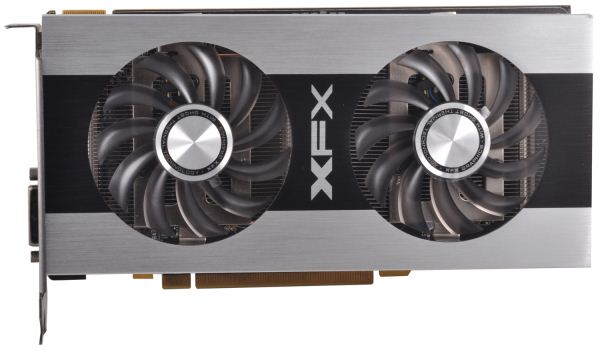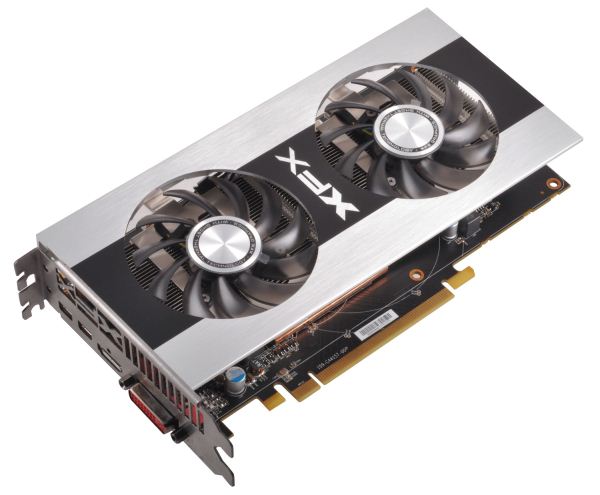AMD Radeon HD 7750 & Radeon HD 7770 GHz Edition Review: Evading The Price/Performance Curve
by Ryan Smith & Ganesh T S on February 15, 2012 12:01 AM EST- Posted in
- GPUs
- AMD
- HTPC
- GCN
- Radeon HD 7000
Meet the XFX R7770 Black Edition S Double Dissipation
Our final card of the day is XFX’s R7770 Black Edition S Double Dissipation, one of a multitude of Radeon HD 7770 cards XFX will be releasing today. XFX will be releasing two factory overclocked Black Edition cards today, with the S edition BESDD being the higher clocked of the two. It will be clocked at 1120MHz core and 5.2GHz memory, which is a 120MHz (12%) core overclock and 700MHz (15%) memory overclock compared to the reference 7770.
Like all the other 7770s being released today XFX is using the AMD reference PCB for the BESDD, so XFX is primarily relying on their factory overclock and their custom cooler to stand apart from AMD’s other partners. To that end the BESDD is very similar to the other XFX Double Dissipation cards we’ve reviewed in the last month. A copper plate sits at the base of the cooler, transferring heat to an aluminum heatsink that runs virtually the entire length of the card. Above that sits a pair of fans and then finally the metal shroud that covers the card.
Overall the design is similar to a number of other dual fan cards we’ve seen in the past, and as we’ll see in our benchmarks the resulting cooling is quite effective. In terms of quality however I feel XFX has missed the mark – the cooler is only attached to the PCB around the GPU, so at 8.25” long there’s nothing retaining the PCB at the far end to keep it from flexing. A stiffener would have been a great idea here, which is something XFX does on the 7900 series. Furthermore in the case of our sample the construction quality was also subpar, as the screws responsible for securing the metal shroud were not properly tightened and thereby leaving the shroud loose. This is nothing 30 seconds with a screwdriver couldn’t fix and I don’t have any reason to believe this is a common problem, but it’s a quality control issue none the less.
As the BESDD uses AMD’s 7770 PCB, the length of the card and display connectivity is identical. The card measures 8.25” long with no cooler overhang, while display connectivity is provided by 1 DL-DVI port, 1 HDMI port, and a pair of miniDP ports.
Rounding out the package is the same collection of extras that we saw in the 7950 BEDD. Inside you’ll find the usual driver CD and quick start guide, along with a metal XFX case badge, a mid-length CrossFire bridge, a DVI to VGA adaptor, and a passive HDMI to SL-DVI adaptor. All of this is packed in one of XFX’s pleasantly small boxes, which doesn’t use much more space than the card itself.
The MSRP on the R7770 BESDD is $184, $25 over the MSRP for a regular 7700 and pushing it well into the territory of the Radeon HD 6870 and GeForce GTX 560. XFX is offering a base 2 year warranty on the R7770 BESDD, which can be extended to a lifetime warranty by registering the card within 30 days of purchasing it.












155 Comments
View All Comments
kallogan - Wednesday, February 15, 2012 - link
HD 6850 is still the way to go.zepi - Wednesday, February 15, 2012 - link
So basically in couple of generations we've gone4870 > 5770/6770 > 7770
Chip size
260mm2 > 165mm2 > ~120mm2 chip.
Performance is about
100 > 100 > 120
Power consumption in gaming load according to Techpowerup (just graphics card):
150W - 108W - 83W
And soon we should have 1 inch thick laptops with these things inside. I'm not complaining.
silverblue - Wednesday, February 15, 2012 - link
Good point. One thing I think people forget is that smaller processing technologies will yield either better performance at the same power, or reduced consumption at the same performance... or a mix of the two. You could throw two cards in dual-GPU config for similar power to one you had two years back, and still not have to worry too much if CrossFire or SLi doesn't work properly (well, if you forget the microstuttering, of course).cactusdog - Wednesday, February 15, 2012 - link
WHy is the 6770 left out of benchmarks?? Isnt that odd considering the 7770 replaces the 6770? I really wish reviewers would be independant when reviewing cards, instead of following manufacturer guidelines.Markstar - Wednesday, February 15, 2012 - link
No, since the 6770 is EXACTLY the same card as the 5770 (just relabeled). So it makes sense to continue using the 5770 and remind AMD (and us) that we do not fall for their shenanigans (sadly, many do fall for it).gnorgel - Wednesday, February 15, 2012 - link
For your 6850. It should sell a lot better now. Maybe they really stopped producing it and need to get rid of stocks. But when it's sold out almost anyone should go for a gtx 560, 7% more expensive and 30% faster.The only reason to buy a 7770 now is if your powersupply can't support it and you would have to get a new one.
duploxxx - Wednesday, February 15, 2012 - link
by the time the 6850 is out of stock the 78xx series are launched which will knock out 560don't understand what evryone is complaining about, its faster then the 57xx-67xx series, les spower. sure it's not cheap but neither are the 57-67 @ launch. Combined with old gen available and NV products a bit to expensive but this is just starting price....
akbo - Wednesday, February 15, 2012 - link
Moore's law apparently doesn't apply to graphic cards. People expectations do. People expect that every two years gpus at the same price point have double transistors and thus be faster by so. Obviously perf does not scale like so since the 28 nm shrink only has a 50% improvement from 40 nm. However that would mean a 50% improvement is expected. Imperfect scaling would mean a 40% improvement.So people expect that a card which is 20% faster than a card from 2 years ago to be 1.2/1.4 the price at launch, or an ~ 85% of the 5770 launch price in this case. That would mean that the card should retail at around $130-140 or so for the 7750 and sub-$100 pricing, like $90 or so. I expect it to be that price too.
chizow - Wednesday, February 15, 2012 - link
Moore's Law does actually hold true for GPUs in the direct context of the original law as you stated, roughly doubled transistors every 2 years with a new process node. The performance has deviated however for some time now with imperfect scaling relative to transistors, but at least ~50% has been the benchmark for performance improvements over previous generations.Tahiti and the rest of Southern Islands itself isn't that much of a disappointment relative to Moore's Law, because it does offer 40-50% improvement over AMD's previous flagship GPU. The problem is, it only offers 15-25% improvement over the overall last-gen performance leader the GTX 580 but somewhat comically, AMD wants to price it in that light.
So we end up with this situation, the worst price performance metrics ever where a new GPU architecture and process node only offers 15-25% performance increase at the same price (actually 10% more in the 7970 case). This falls far short of the expectations of even low-end Moore's Law observer estimates that would expect to see at least +50% over the last-gen overall high-end in order to command that top pricing spot.
arjuna1 - Wednesday, February 15, 2012 - link
DX11.1?? With only one true DX11 game on the market, BF3, there is literally no incentive to upgrade to this generation of cards 7xxx/kepler.Unless nvidia comes out with something big, and I mean big as in out of this world, I'll just skip to the next gen, and if AMD insists in being an ass with pricing, I'll go Ngreen when the time comes.
Now, the worrying thing is that it's becoming evident, both parties are becoming too cynical with price fixing, when is that anti trust lawsuit coming?